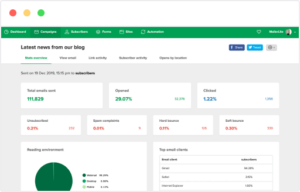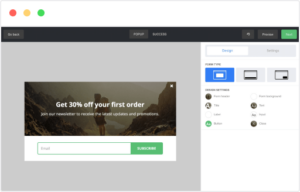There’s a number of real-life problems you need to address if you want your marketing projects to be successful. We track them down here and discuss the best ways to address them.
If you want to make money with a website or with your blog (as well as some other types of online content, from Channels on Youtube to LinkedIn profiles and more), then you’ll find out that the real world looks different from the shiny ads that usually tell you how easy this is and that promise you quick success (if not riches overnight, as that’s what most of them correctly do warn about). What they do not tell you though is that the devil is in the details here as much as that’s the case in so many other areas in real life.
Image: MaileLite is one of the really great solutions you might want to check out!
For example, it does not take just 14 minutes to set things up and get going with a new campaign — not even if you happen to actually have an existing audience of a few thousand people! (I am not saying it can’t be done, but I am saying that even with a sound following, for the average Joe it takes a few hours — more realistically, you should plan on 1-2 full work days — to set up your Facebook Ads or Google Adwords campaign (or, ideally, one with some less-monopolistic platform) and really get going.
Here’s Why
If you’re like most of us, you first need to build your audience. Even if you already have one (that you want to grow bigger), you’d have to do a bunch more tweaks and actions than simply uploading a target audience address list to one of those platforms. In real life, you’d also have to modify lots of settings and double-check whether or not old ones are right for your current campaign. And that’s true even in case you’re pretty savvy with one (or many) of those platforms. This is where the problems usually start — mostly because Facebook and Google seem to have forgotten what the web really is and what a web frontend needs to look like (as they increasingly mistake websites and form input with cartoons or, at any rate, needless Flash animations. This takes an extra amount of time (and internet bandwidth, therefore sometimes more delays but in any case more energy than a lean website and graphics card in a machine running your web client would consume) and it serves no real purpose. (Do note that Facebook Ads looked pretty neat — and worked even more neat back when they did not have these useless effects and animation add-ons in the earlier 2000s. I used to do pretty well with those tools back in the day. Today, it’s not so much fun.) Also, the range of “features” has, admittedly, gotten wider these days. This may be good in some ways but, again, it takes so much more time to digest, handle, and finally set up and actually get done with it that one may actually doubt if it’s worth all the extra effort under a true cost-benefit analysis. Then, there is ad review. Which is faster on Facebook than on Google (sometimes it’s done within 15 to 60 minutes or so which is pretty much okay). Then, however, there’s also automatic scripts that continue to “review” your ads for some arcane “violations” of “policies” and what not that are often conjured out of thin air. (Even if they actually happened to be published somewhere in the Terms of Use, yes the ones that you actually “agreed” to after all (really, so you actually do read this garbage?!?), then it could be argued that in at least 50% of incidents they interpret their own stuff wrong, but accuse you — and block your account! — anyway.) If that type of bad luck strikes, then you can add another 2-3 days minimum to your Advertising schedule to get these things sorted out, and you campaign actually going.
So Far, So Good
Now you at least have a working online campaign running that advertises your website, your landing page, lead magnet or whatever you have. That’s the one to two days minimum I mentioned above.
Then there is campaign optimization though. And lots of it. Depending on where you run your ads, you’ll have an easier or a hard time figuring out what’s wrong when your ads happen to bring in disappointing results. We will get into more detail in separate articles on this website (that will be linked here, so keep watching for them to be released). If you happen to be on Google which — despite tons of reservations against that provider — I’d still suggest you start out with, then you’re in luck. Or so it seems. The reason being that Google’s algorithms crunch and re-crunch your campaign data and throw a bunch of suggestions at you — do this, delete that, optimize yet another thing, etc-yada-yada. Not so yada-yada though, if you want to be absolutely technical… For following those (somewhat annoying) algorithm-generated suggestions immediately results in improvements of your campaign results with Google. That’s a good thing, isn’t it. Well, that depends. If you believe reality is what Google says it is, then yes, you must be happy with this. If you are a human, and if you on top happen to be able and still think and maybe even outsmart your smart phone then it’s a different story. Still, following Google’s suggestions does work — not necessarily because they are geniuses at Google, but rather because they are so heavily influencing user behavior simply because of Google’s market share that — ultimately as a self-fulfilling “prophecy” — it is correct what they say. Because if the audience is influenced by their getting used to Google’s layout, style and Ads appearance, then your ads will work best if you actually follow this very set of features to the t — because you must properly pitch your content to your audience (or Google’s, to be honest). Anyway this is how things are these days, and you must know it if you want to succeed in this world — or in what has become of it.
Also do note that recommendations, whether automatic or not, are not always in your best interest (which would be advertising to as many users as possible with spending as little as possible) but — more than just occasionally — rather in Google’s or Facebook’s interest — and that would be making an as large as possible profit even if you pay more than necessary per click, per action, per visitor — W-r-i-t-e T-h-a-t D-o-w-n!
By now it should be pretty clear though, that “14 minutes” is a bit cocky and unrealistic, and that things actually take some time when you set your campaigns up for the first time. Even if you’re pretty experienced and you’re doing it for the ump-teenth time, it’ll usually take you a few hours. (Those claimed “14 minutes” apparently mean clicking a new ad text into one of your campaigns if you happen to have everything in place before you even start the clock — maybe because you’re running dozens of campaigns per month or week. But that’s certainly not the average Joe, and that’s why it’s best to use more caution and not have too high an expectation before you set out.)
All this doe not mean it couldn’t be done though. It doesn’t mean that wasn’t fun and it doesn’t mean that it wasn’t profitable. It is. It is all of it.
Simply Do Not Expect any Wonders Just Yet
To read hands-on advice and get actionable information on how to really get your online marketing campaign and your audience-building efforts off the ground, read our other articles on this website and watch selected videos from our video collections and online courses.

